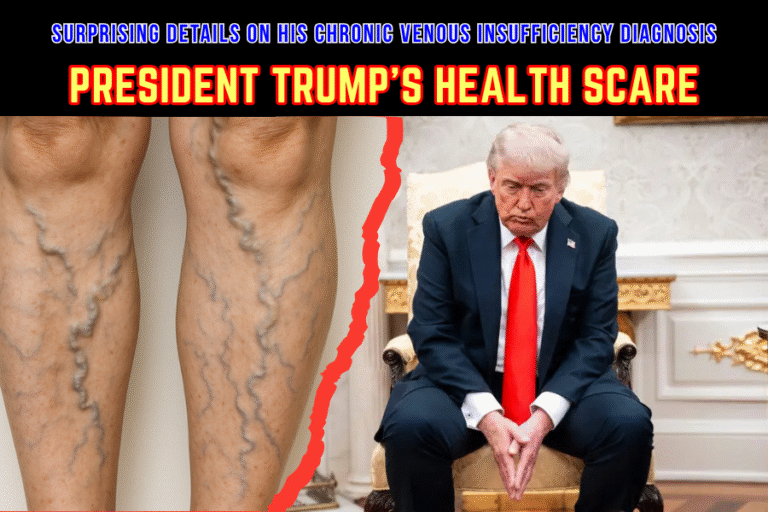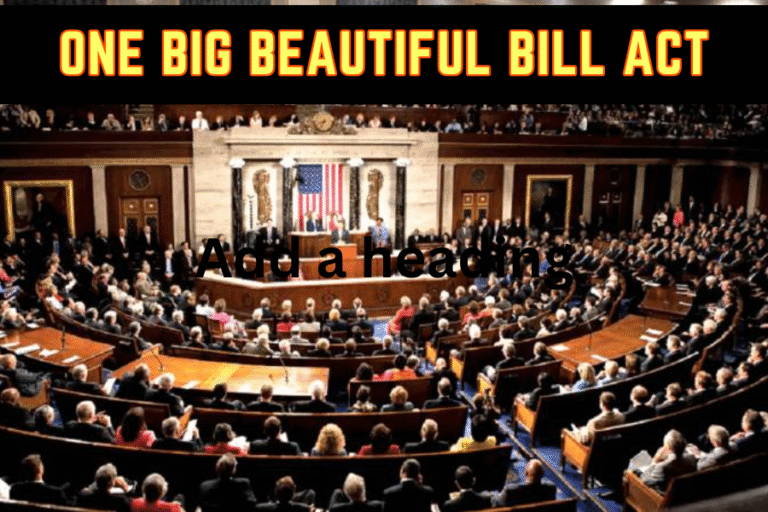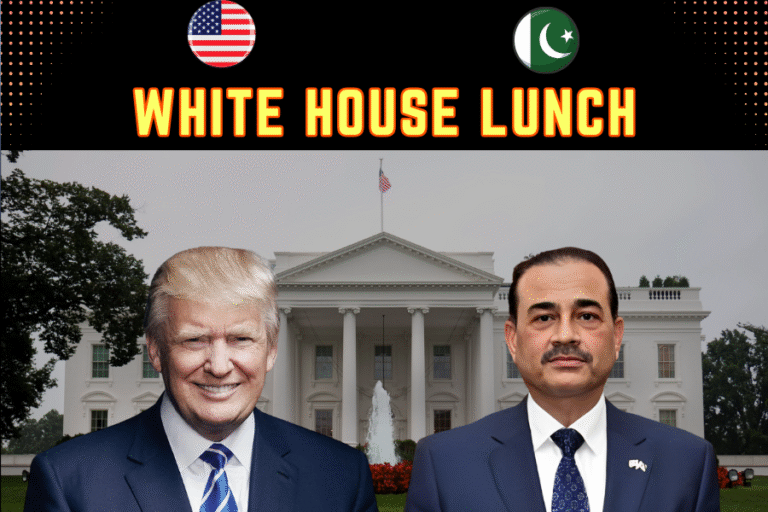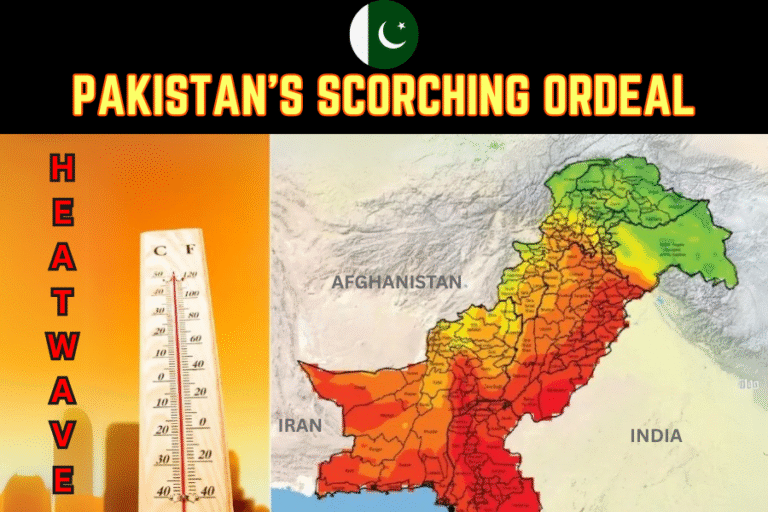(By Khalid Masood)
When President Donald Trump unveiled his 20-point Gaza Peace Plan on September 29, 2025, it set off ripples across the world. Framed as a sweeping roadmap to end the Israel–Hamas war, the proposal promises an immediate ceasefire, hostage exchanges, Israeli withdrawal, and the establishment of a transitional, technocratic governance structure in Gaza under international supervision. Israel has formally approved it, but Hamas remains hesitant. In Pakistan, what stirred strong reactions was Prime Minister Shehbaz Sharif’s unusually swift endorsement of Trump’s plan — a move that raises deep questions about diplomatic strategy, moral responsibility, and whether Pakistan’s leadership leaped before fully scrutinizing the hidden strings.
Overview of the 21-Point Plan
The plan, shared via U.S. envoy Steve Witkoff’s proposal, envisions an immediate end to hostilities if accepted by Israel and Hamas, followed by reconstruction, deradicalization, and a vague “pathway” to Palestinian statehood. It positions Gaza as a “de-radicalized, terror-free zone” under transitional international oversight, with no role for Hamas in governance. Key stakeholders include the U.S. (leading a new “Board of Peace” potentially chaired by Trump himself, alongside figures like Tony Blair), Arab partners (e.g., Saudi Arabia, UAE), European allies, the UN, and a reformed Palestinian Authority (PA). Reconstruction would involve massive aid surges (at least 600 trucks daily, per prior benchmarks) and economic zones to attract investment.
For clarity, here’s a tabulated summary of the 21 points:
| Point | Key Provision | Implications |
|---|---|---|
| 1 | Gaza as a de-radicalized, terror-free zone posing no threat to neighbors. | Aims for security but risks labeling legitimate resistance as “terrorism.” |
| 2 | Redevelopment of Gaza for its residents’ benefit. | Positive for humanitarian relief, echoing calls for ummah-wide aid. |
| 3 | Immediate war end upon agreement: IDF halts operations and withdraws gradually. | Ceasefire is a win, but “gradual” withdrawal could prolong occupation. |
| 4 | All living/deceased hostages returned within 48 hours of Israeli acceptance. | Urgent humanitarian priority; aligns with Islamic values of mercy. |
| 5 | Israel frees hundreds of Palestinian prisoners (life sentences) and 1,000+ detainees, plus bodies. | A step toward justice, but disproportionate to Palestinian suffering. |
| 6 | Amnesty for peaceful Hamas members; safe passage for others to leave. | Divides resistance fighters—potentially weakening Palestinian unity. |
| 7 | Aid surge (≥600 trucks/day) + infrastructure rehab and rubble removal. | Essential for Gaza’s 2.3 million Muslims; Pakistan could contribute via OIC. |
| 8 | Aid distribution by neutral bodies (UN, Red Crescent, non-partisan orgs). | Reduces Hamas interference but sidelines local agency. |
| 9 | Temporary technocratic Palestinian government, supervised by U.S.-led international body. | Transitional stability, but foreign oversight erodes sovereignty. |
| 10 | Economic rebuilding plan with Middle East city-building experts and job creation. | Opportunities for Gulf investment; benefits Pakistan’s labor export ties. |
| 11 | Economic zone with reduced tariffs negotiated by participants. | Boosts trade, but favors Israeli/Gulf interests over Palestinian control. |
| 12 | No forced expulsions; return rights for voluntary emigrants; incentives to stay. | Rejects ethnic cleansing— a moral victory for Muslim advocacy. |
| 13 | No Hamas governance; destroy offensive infrastructure (e.g., tunnels); commit to coexistence. | Demilitarizes resistance, echoing colonial disarmament tactics. |
| 14 | Regional security guarantees for compliance. | Arab buy-in (e.g., Saudi) could stabilize, but at what cost to Palestinian arms? |
| 15 | U.S.-led international stabilization force to deploy, train Palestinian police. | Short-term security, but risks turning Gaza into a protectorate. |
| 16 | No Israeli occupation/annexation; phased IDF handover to new forces. | Prevents full takeover, vital for two-state viability. |
| 17 | If Hamas rejects, proceed in “terror-free” areas handed to international force. | Punitive clause; pressures resistance into submission. |
| 18 | Israel halts strikes in Qatar; acknowledge Doha’s mediation role. | Diplomatic nod to Muslim hosts of Hamas leaders. |
| 19 | De-radicalization via interfaith dialogue to shift narratives. | Well-intentioned, but top-down “re-education” smacks of cultural erasure. |
| 20 | Pathway to Palestinian statehood post-redevelopment and PA reforms. | Aspirational two-state goal, long championed by Pakistan at the UN. |
| 21 | U.S.-facilitated Israel-Palestine dialogue for political horizon. | Builds on Oslo, but lacks enforcement—history shows U.S. bias toward Israel. |
Possible Strengths of the Plan:
- Ceasefire & Hostage Release
Any plan that includes immediate ceasefire and return of hostages is positive — it can stop the bloodshed, save civilian lives, and reduce humanitarian crisis. - International Oversight & Transitional Governance
If Gaza is governed temporarily by a technocratic or international authority (with Palestinian leadership involvement), that might ensure accountability, reduce chaos, and help rebuild infrastructure. - Conditional Statehood / Two-State Framework
The plan reportedly includes a vague path toward Palestinian statehood, which is in line with longstanding international consensus and Muslim world demands.
Key Weaknesses, Risks, and Moral Concerns:
- Exclusion of Hamas without Local Buy-in
Since Hamas controls significant parts of Gaza and has deep support among Palestinians (as a result of the history and ongoing distress), excluding it entirely may generate resistance, undermine legitimacy, and prolong conflict. - Disarmament & Withdrawal Conditions
Requiring Hamas to disarm and Israel to withdraw under strict conditions might be one-sided if mechanisms for monitoring, trust, compensation, and security guarantees are weak or absent. - Humanitarian Realities & Casualties
The damage in Gaza is already enormous. Ceasefires may stop new violence but cannot undo trauma, loss of life, destruction of homes, infrastructure, displacement, and famine. Delays or half-measures could continue suffering. - Power Imbalances & International Control
Plans that put heavy decision-making in international or foreign bodies risk sidelining Palestinian agency. If Palestinians feel their fate is being decided by outsiders (or by parties aligned with Israel), trust will be eroded. - Implementation Challenges
Even with leaders’ verbal acceptance, logistics are hard: disarmament, monitoring, reconstruction, compensation, border control, asylum/displacement concerns, etc. Also political resistance in Israel and among hardliners could block or delay parts of the plan.
Shehbaz Sharif’s Immediate Acceptance: Analysis
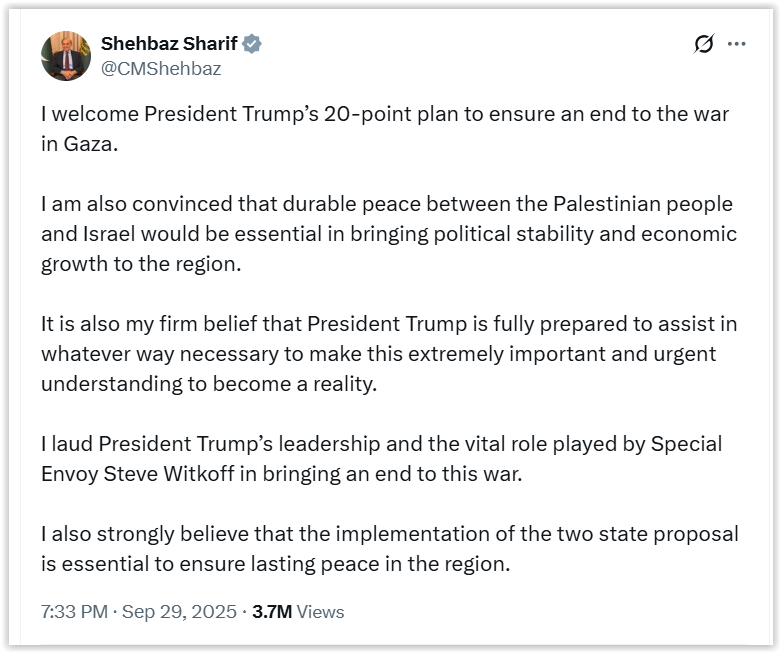
Possible Reasons for Quick Support:
- Diplomatic Positioning
Pakistan has for decades supported Palestinian statehood, decried violence against civilians, and called for peace. Accepting a peace framework early allows Islamabad to be seen as a constructive participant rather than a critic. This may boost its international standing among Muslim countries and global forums. - Moral & Political Consistency
Pakistani leaders need to respond quickly to overtures promising peace. Not doing so might invite criticism at home (for being insensitive to Palestinian suffering) and among other Muslim / Arab nations. - Geopolitical Pragmatism
Pakistan may be interested in stronger ties with the United States and Arab countries, and therefore might welcome being part of the diplomatic process. Also, hope for restoring or elevating voice in international affairs. - Domestic Political Gains
Support for the Palestinian cause is highly valued in Pakistani public opinion. Backing a peace plan might gain political goodwill, especially in view of criticism over past responses or inaction.
Risks / Criticisms of Accepting Too Quickly:
- Lack of Detail / Guarantees
The plan is still vague in many respects. Accepting without knowing how key concerns (e.g. disarmament, withdrawal, Hamas role, who monitors what) will be handled carries risk. - Alienating Palestinian Voices
If the plan excludes Hamas but does not address root grievances, displacement, siege, etc., Pakistan’s early backing might be seen by some Palestinians as aligning with a plan that undermines their autonomy or fails to protect justice. - Policy Instrumentalization
There’s a risk that Pakistan’s acceptance is being used by the US or Israel to claim “broad Arab / Muslim support,” which might reduce pressure on Israel for accountability. Pakistan must ensure its support is conditional on justice, human rights, and adherence to international law. - Domestic Backlash
If peace does not come, or if the population perceives the plan as insufficient or unjust, there could be domestic criticism. Pakistan’s government must clearly communicate to its populace what it can (and cannot) guarantee.
What Pakistan Should Insist On / Watch Closely
Pakistan should:
- Demand inclusion of Hamas or at least Palestinian consent in negotiations or governance structure, to ensure legitimacy.
- Secure guarantees on ceasefire implementation, end of civilian harm, access to humanitarian aid without obstruction.
- Push for clear timeline and monitoring mechanisms (independent, transparent).
- Ensure Palestinian ownership in any transitional or technocratic body.
- Insist on restoration of rights, legal justice, compensation, return of displaced persons under international law.
- Maintain Pakistan’s support for the two-state solution based on 1967 borders with East Jerusalem / Al-Quds as capital.
Conclusion
Trump’s plan is a flawed olive branch that Pakistan should engage critically, not embrace wholesale. For the ummah, true peace demands equity, not erasure. Sharif’s nod is a diplomatic masterstroke if leveraged for Palestinian gains; otherwise, it’s a misstep in our storied fight for justice. Allah-o- Akbar—may Gaza rise sovereign and free.




